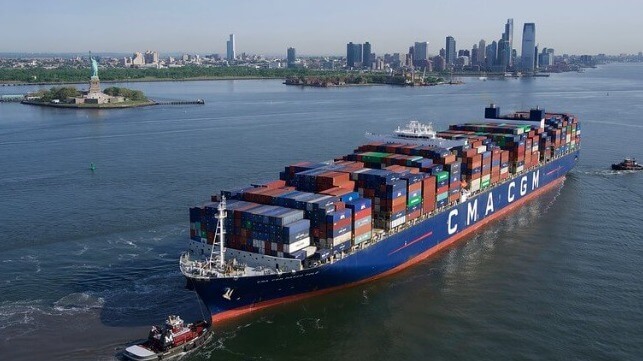NY/NJ Port Plans Carrier Container Imbalance Fee Based on Volumes

As ports around the world are struggling to keep up with record volumes and manage the growing number of containers in their yards, the Port of New York and New Jersey has come up with a unique approach announcing plans to launch a quarterly “container imbalance fee” for ocean carriers. The port authority is urging ocean carriers to clear long-dwell empty containers from port property as the peak cargo season approaches, but instead of measuring progress by dwell time, the port will base the fee on the ratio of outgoing to incoming containers moved by each carrier.
“The Port of New York and New Jersey is facing record import volumes, leading to empty containers accumulating in and around the port complex that are now affecting the regional supply chain that is already under stress from various sources across the country,” said Bethann Rooney, director of the Port Department at the Port Authority of New York and New Jersey. “We emphatically encourage ocean carriers to step up their efforts to evacuate empty containers quicker and at higher volumes to free up much needed capacity for arriving imports in order to keep commerce moving through the port and the region.”
The port authority announced today that a container imbalance fee will be assessed on ocean carriers that do not evacuate empty containers that are taking up sorely needed space for arriving imports and impede overall port productivity. Under its new container management fee, which will be assessed quarterly starting September 1, ocean carriers’ total outgoing container volume must equal or exceed 110 percent of their incoming container volume during the same period, or they will be assessed a fee of $100 per container for failing to hit this benchmark. Incoming and outgoing containers include both loaded and empty containers, excluding rail volume.
Other ports have also increased their emphasis on empties with a range of efforts to reduce the backlogs that they say are slowing the movement of containers through their facilities. The Port of Oakland, California, for example, lowered the number of free days for containers sitting in the yards. Last fall, the ports of Los Angeles and Long Beach announced plans for a dwell time fee saying their facilities were overloaded with empties. They encouraged carriers to bring in vessels to sweep the ports and as a result, the fee of $100 per container that increases $100 a day after exceeding the dwell time threshold has been postponed for the past nine months while the ports continue to access if or when they would implement the fee.
The Port Authority of New York and New Jersey says it has met with ocean carriers both individually and as an industry and identified additional mitigation strategies, conducting targeted outreach to shipping companies and cargo owners currently storing their import containers within the port for excessive periods. The Port Authority has also taken other steps to manage the empty containers, including the repurposing of 12 acres within Port Newark and the Elizabeth-Port Authority Marine Terminal for temporary storage, and is in the process of negotiating or investigating additional storage space.
Port Authority Executive Director Rick Cotton said the new proactive container management approach is an example of the port's efforts to identify and implement solutions before they cause logjams. The port authority reports its seaport has been handling a cargo increase of nearly 12 percent year-to-date compared to last year and a 34 percent increase in cargo volume compared to the same period in 2019 before the pandemic.
Volumes at the U.S. East Coast ports have been on the rise in recent months with industry analysts pointing to a shift of traffic away from the West Coast as well as the surge in imports coming on the traditional routes serving the ports. Marine Traffic recently reported that 17 containerships were waiting at the Port of New York and New Jersey, which is the largest East Coast container port, with growing numbers of vessels also waiting at other major East Coast ports including Savannah and Charleston.
The Port Authority of New York and New Jersey said the proceeds from the new container imbalance fee will be used to offset the costs of providing additional storage capacity, and other expenses incurred by the glut of empty containers.
The container management fee is pending a mandatory federal 30-day notice period. The Port Authority has commenced a public comment period before the planned start of the fee on September 1. They are reporting that the fee will be reassessed when the global supply chain crisis eases. A review by the port’s board of commissioners is needed no later than September 2023 under the agency’s rules.
